What Is Digital Dropshipping? A Beginner's Guide to Boosting Your Online Business

If you've ever considered starting your own online store but were worried about the upfront costs and risks of holding inventory, digital dropshipping could be a great low-risk option for you.
Digital dropshipping is a distinctive and convenient approach for prospective entrepreneurs to build their presence and make money in the huge world of online commerce. In this guide, let’s go deep into the world of digital dropshipping to give you a complete grasp of the idea, its workings, and how to succeed there.
What Is Digital Dropshipping

Digital dropshipping refers to a model where online retailers sell digital products such as e-books, online courses, software licenses, viral videos, music downloads, etc., without owning the inventory themselves.
Digital dropshipping leverages the delivery of digital products directly from creators to customers, enabling online retailers to profit from sales without owning or distributing the digital inventory themselves.
How Digital Dropshipping Works
Digital dropshipping allows retailers to sell a wide range of products with zero upfront costs and inventory risks, while suppliers maintain fulfillment.

|
Find Better Supplier For Products DSers Supplier Optimizer - One click to filter out the most proper suppliers for your products |
Both parties benefit through an expanded sales channel. Here’s how a digital dropshipping model works:
Retailer finds products to sell
The retailer searches for in-demand digital products they can sell, such as ebooks, online courses, software licenses, etc. They find suppliers/creators willing to dropship these products.
Retailer sets up an online store
The retailer builds a website or online storefront to promote and sell the products they represent. This is where customers will place orders.
Customer places order
When a customer buys a product listed on the retailer's site, they enter their payment and shipping details.
Retailer notifies supplier
The retailer immediately notifies the product supplier of the sale, providing customer and payment information.
Supplier fulfills order
The supplier validates payment and then delivers the digital product directly to the customer. For example, they may email a download link for an ebook.
Retailer receives commission
The supplier deducts an agreed commission from the sale amount and transfers the remaining funds to the retailer.
Supplier delivers directly to the customer via email or any online channel
The supplier handles all aspects of fulfilling and delivering the order directly to the customer. The retailer is never in possession of inventory.
Pros and Cons of Digital Dropshipping
Digital dropshipping offers a variety of advantages that appeal to business owners. It also has some drawbacks compared to the traditional dropshipping models.

|
Adapt Your Product Prices Automatically DSers Automatic Pricing - Pre-set Pricing Rule to mark-up your product price automatically |
Let’s check out its pros and cons to make your own decision on developing your own digital dropshipping business.
Digital dropshipping removes the multiple risks and fulfillment overheads of traditional models through its entirely digital inventory and delivery process. Here are some key advantages of digital dropshipping over traditional dropshipping:
No inventory and fulfillment costs
Digital products don't require capital to purchase, store, and protect inventory upfront. This significantly reduces the financial risk and barriers to entry. Traditional dropshipping involves significant costs for packaging, labeling, shipping, and fulfillment centers. Digital dropshipping passes this cost to suppliers.
Instant delivery
Fulfillment is immediate as digital goods are electronically delivered. There's no time spent packaging, shipping, and waiting for the delivery of physical goods.
No returns/replacement risks
Challenges like incorrect shipping addresses, damaged goods in transit, and returns/replacement handling are non-existent for digital goods.
Easier product sourcing and streamlined operations
It's simpler to find suppliers of in-demand digital content versus physical inventory worldwide. Agreement terms are clear-cut. Digital delivery is automated requiring no extra manpower at the dropshipper's end for logistics, customer service, etc.
Green and fast
Compared to physical shipping, digital distribution has no environmental impact and is nearly instantaneous.
Global scalability and well-suited for global customers
Digital goods can be delivered worldwide easily at low costs. This allows Dropshippers to expand into global markets easily. Time zone differences are non-impactful as digital goods access is 24/7 globally via the internet.
The intangible nature of digital goods opens up new risks around competition, piracy, and customer retention for the dropshipper's business. Here are some potential disadvantages of digital dropshipping compared to traditional dropshipping:
Limited product selection
The selection of suitable digital products may be narrower than physical goods. This can constrain the types of stores and niche markets that can be tapped.
Increased competition and difficulty to stand out
Digital domains tend to get saturated quicker as barriers to entry are lower. This means more competition for eyeballs and market share. With many similar dropshippers offering the same digital products, it requires more effort to carve a unique niche and branding.
Price sensitivity
Customers may be more cost-conscious for digital goods that don't involve shipping costs. Margins could be smaller.

|
Adapt Your Product Prices Automatically DSers Automatic Pricing - Pre-set Pricing Rule to mark-up your product price automatically |
Piracy and subscription risks
Digital content is more easily shared without purchase. Anti-piracy measures need to be strong to prevent revenue losses. Recurring subscription/membership models require an excellent customer retention strategy.
Reliance on third parties
Dropshippers depend entirely on suppliers/creators for fulfillment. Issues could impact the customer experience and business.
Intangible products
Lack of physical goods means fewer upsells and abandoned cart recovery potential during checkout.
Payment issues
Digital goods demand secure payment solutions and buyer protection to build trust for intangible products.
5 Best Digital Product Suppliers
Digital product suppliers can offer diverse, in-demand digital content across categories that are easy to represent and deliver at scale for dropshipping stores. Let’s check out some outstanding names in this part.
1. Creative Fabrica
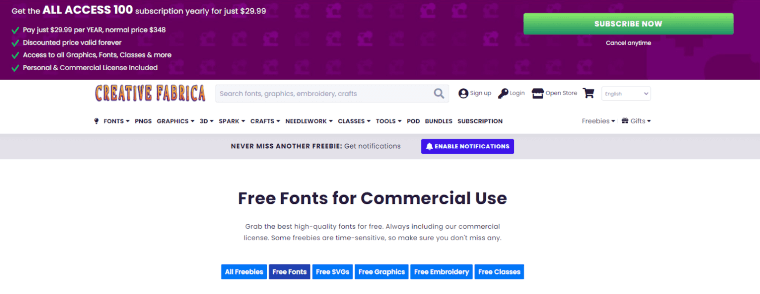
Creative Fabrica is an online marketplace for graphical design assets such as fonts, icons, templates, graphics, and more. Creative Fabrica has one of the largest selections with over 350,000 design assets.
This ensures plenty of inventory options. Basic design elements like fonts, icons, and templates have ongoing demand and sales potential. They are not transient trend-based products.
Sellers can offer individual products or bundles, memberships, and subscriptions for recurring income. Items are organized into specific design niches like fonts, social media graphics, webpage layouts, etc. making it easier to build digital dropshipping stores.
Dropshippers don't have to worry about copyright issues or content production costs. Commissions averaging 35-45% provide generous margins compared to alternative industry standards.
With 10+ years in business, Creative Fabrica has built strong brand trust with end customers. Their vast, diverse catalog and royalty-free business model make them an ideal supplier for low-effort, high-margin digital dropshipping stores.
2. Udemy

Udemy is one of the largest online learning platforms where experts share their knowledge through video courses on various topics. If you decide to choose online courses for your digital dropshipping business, Udemy should be the first option.
The huge catalog, recurring revenue from new releases, absence of fulfillment, and Udemy's global reach and credibility make Udemy an outstanding supplier. Some outstanding features of Udemy for digital dropshipping can be listed as follows:
Huge course selection and wide appeal
Udemy has over 200,000 video courses on practically any topic, ensuring plenty of inventory options. Courses cover professional/creative skills, programming, business, lifestyles, etc., to diverse audiences.
Global audience and trusted brand
As the world's largest online learning marketplace, Udemy already has a large consumer base. As the largest online learning platform, Udemy has strong brand recognition and credibility.
Good commission for dropshippers
Dropshippers earn 50% commission on all referred sales with no monthly fees. Highly competitive in the market.
Payment processing
Udemy's platform shields dropshippers from handling payments or customer financial details.
Instant delivery
Downloads are immediate once payment is cleared, no need for dropshipper fulfillment.
3. Envato Elements
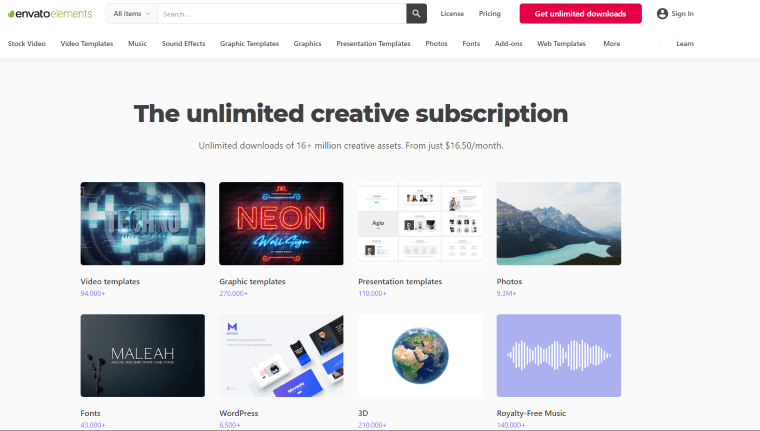
Envato Elements is a subscription-based stock media library that provides access to millions of creative assets. Envato Elements provides dropshippers with a wide range of digital products for web development.
It has over 1.5 million stock photos, vectors, templates, and design assets. Thousands of new items are added weekly by designers, keeping the catalog fresh.
Price and commission are also good reasons that make Envato Elements become one of the first choices for digital dropshipping businesses. Envato has competitive affiliate rates, and earning 50% commission on referred sales with no added fees is attractive.
Global reach and trusted brand are also strong points of Envato. As one of the largest marketplaces, Envato Elements already has a huge base of designers and buyers. Customers are assured of professionally designed, high-resolution digital products.
4. AudioJungle
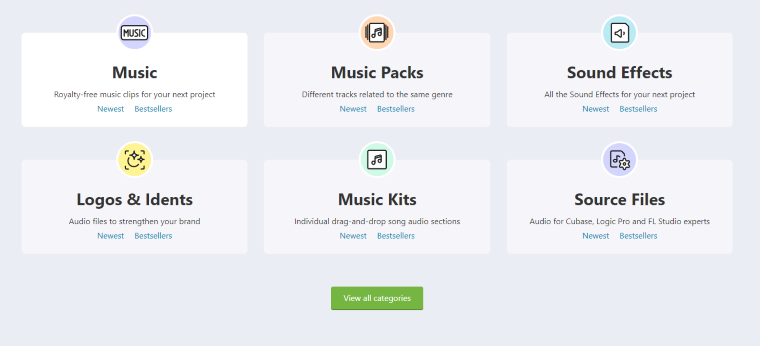
AudioJungle is an online marketplace that allows creators to sell royalty-free stock audio files like music tracks, sound effects, and ambient audio recordings.
If you are interested in audio digital products, AudioJungle seems to be the best option for digital dropshipping suppliers. It has a huge selection of royalty-free music/audio with over 750,000 high-quality tracks across many genres and moods to choose from. Thousands of new tracks added monthly ensure constantly refreshing inventory.
AudioJungle also has competitive affiliate rates with up to 50% commissions on sales with no monthly or listing fees. Besides, with the royalty-free model, content can be resold without limitations, enabling recurring revenue streams.
5. Gumroad

Gumroad is an online platform that enables creators and entrepreneurs to sell their digital products like ebooks, online courses, templates, presets, etc directly to customers.
Gumroad allows sellers to offer flexible product types like downloadable files, memberships, subscriptions, etc. This allows dropshippers to build diverse niche stores. Dropshippers can set their own product pricing, payment options, and delivery methods with complete autonomy. Supplier terms do not restrict them.
Unlike marketplaces taking cuts, dropshippers get to keep the full sale revenues of referred products on Gumroad. In addition, Gumroad has detailed sales reports that help dropshippers improve store optimization and performance over time.
Top 6 Digital Dropshipping Products
A right digital dropshipping product is the key to dropshipping success. Here we list some products that are good for digital dropshipping. Let's check them out one by one.
1. Ebooks
The ebook market is booming, with projected revenues of $14.6 billion in 2024. Ebooks are an excellent choice for digital dropshipping because they require no physical inventory, minimizing overhead costs.
With a wide range of topics available—from fiction to self-help and educational material—sellers can cater to varied interests. Partnering with authors and publishers allows you to offer exclusive titles, enhancing your store’s appeal.
2. Online Courses
Online courses offer flexible learning opportunities across diverse subjects, making them highly sought after. This format allows individuals to develop new skills at their own pace, from coding and graphic design to cooking and fitness.
By collaborating with course creators or educational platforms, you can provide valuable content while benefiting from high profit margins. The demand for continuous learning makes online courses a lucrative digital dropshipping product.
3. Digital Artwork
Digital artwork encompasses everything from illustrations and graphic designs to photography. It offers versatility, as customers can use these artworks for personal projects, digital backgrounds, or even print them for physical display.
By curating a selection of unique digital art from various creators, you can attract art enthusiasts and collectors. This niche can be particularly appealing for those with a keen eye for aesthetics and a passion for promoting artists.
4. Software Licenses
Selling software licenses is a profitable avenue in digital dropshipping, thanks to high profit margins—often as much as 75%. Software products can range from productivity tools to design applications and security software.
By partnering with software developers, you can offer licenses directly from your store, providing customers with easy access to essential tools. This model not only simplifies the purchasing process for users but also allows you to tap into the growing tech market.
5. Stock Photos
Stock photos are in high demand among businesses, marketers, and content creators who need high-quality images for their projects. By curating a library of stock images from photographers and artists, you can provide valuable resources to your customers.
The key is to focus on niche markets or specific themes that cater to particular industries or lifestyles, enhancing your store's unique offerings. Effective marketing strategies will help you reach your target audience and drive sales.
6. Music
The demand for digital music continues to grow, especially with the rise of video content creation on platforms like TikTok and YouTube. Offering music tracks, sound effects, and licensing options for creators can be a lucrative niche in digital dropshipping.
Collaborating with musicians and audio producers allows you to curate a diverse selection, appealing to various content creators. This product category has low overhead costs and can yield high profit margins, making it an attractive option for dropshipping entrepreneurs.
Strategies to Boost Your Digital Dropshipping Business
To foster customer attraction and facilitate the growth of your digital dropshipping venture, it's imperative to employ effective marketing strategies:
1. Social Media Engagement
Establish a robust presence on Instagram, Facebook, and Pinterest platforms. Utilize these channels to exhibit your digital merchandise and engage with your desired clientele.
2. Content Creation
Produce valuable content, such as blog articles and videos, that educates, entertains, or inspires your audience. This approach can facilitate organic traffic generation and position your brand as an authoritative figure within your niche.
3. Email Outreach
Gather email addresses from your website visitors and leverage them to disseminate targeted, compelling emails. These emails highlight your digital offerings and foster stronger customer relationships.
4. Influencer Collaboration
Forge partnerships with influencers operating within your niche. These influencers can endorse your digital products to their followers, enhancing your brand's visibility and credibility.
5. Search Engine Optimization (SEO)
Enhance the visibility of your website and content on search engines like Google. Employing basic Shopify SEO techniques can kickstart the process of optimizing your Shopify store.
6. Paid Advertising
Leverage platforms such as Google Ads, Facebook Ads, and Instagram Ads to expand your reach and drive qualified traffic to your digital dropshipping storefront.
Conclusion
In summary, digital dropshipping is a low-overhead e-commerce model that allows entrepreneurs to sell digital products. The digitally focused nature of this business model makes it a practical venture for creative entrepreneurs and a scalable way to profit from the booming online design product industry with minimal overhead or prior experience required.
Leveraging the reach and services of trusted top supplier platforms forms the backbone of a successful digital dropshipping strategy.
Discover more helpful dropshipping guides on DSers Blog.




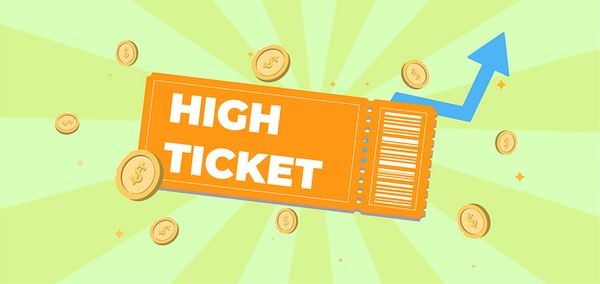
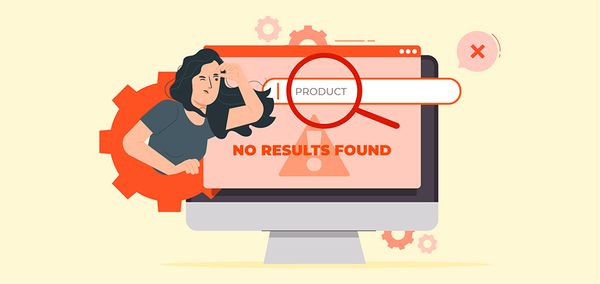






 Company
Company
 Why Choose DSers
Why Choose DSers
 Blog
Blog
 Help Center
Help Center




 Live Chat
Live Chat